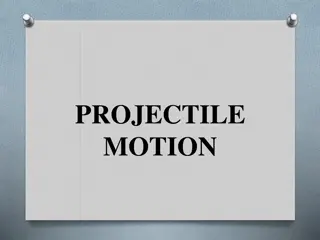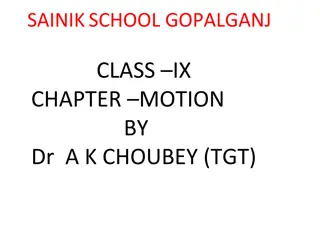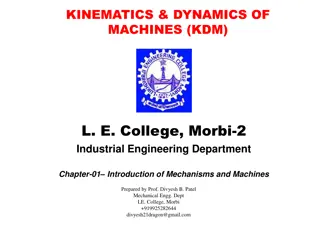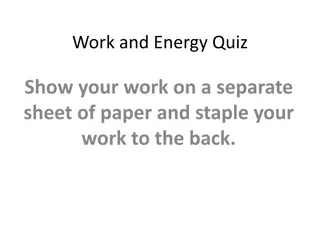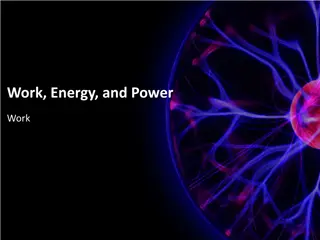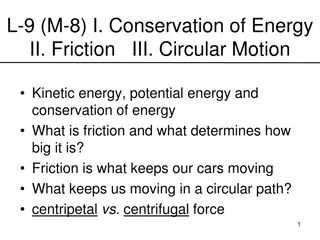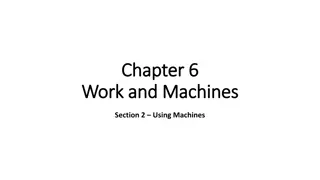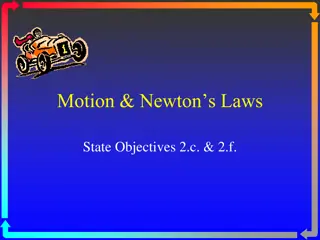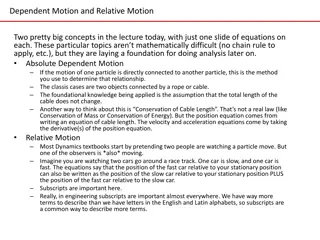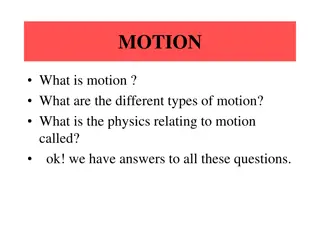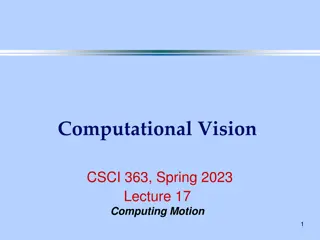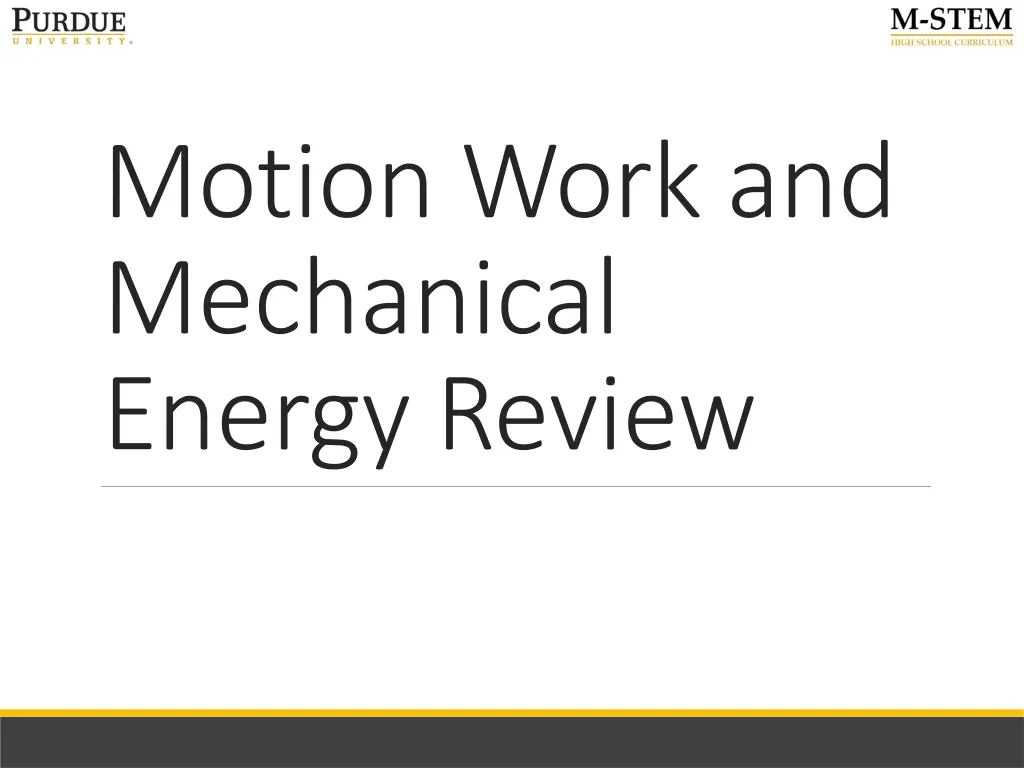
Understanding Motion, Work, and Mechanical Energy in Physics
Explore the concepts of motion, work, and mechanical energy in physics with topics such as inclined planes, weight components, acceleration, equilibrium, mechanical advantage, and levers. Understand how forces and motion interact in various scenarios.
Download Presentation

Please find below an Image/Link to download the presentation.
The content on the website is provided AS IS for your information and personal use only. It may not be sold, licensed, or shared on other websites without obtaining consent from the author. If you encounter any issues during the download, it is possible that the publisher has removed the file from their server.
You are allowed to download the files provided on this website for personal or commercial use, subject to the condition that they are used lawfully. All files are the property of their respective owners.
The content on the website is provided AS IS for your information and personal use only. It may not be sold, licensed, or shared on other websites without obtaining consent from the author.
E N D
Presentation Transcript
Motion Work and Mechanical Energy Review
Inclined Planes Two dimensional motion describes, o Two Dimensional Force Vectors such as with Inclined Planes o Motion in a Curved Path such as with Projectile Motion Weight of an object on an Inclined Plane is always acts downward mg
Weight Components on an Inclined Plane Since the components are perpendicular to each other they form a right triangle. Acceleration of the box is a result of gravity acting on the crate to pull it downward. We can find the acceleration with the sine and cosine functions from our trigonometric pneumonic, SOH-CAH-TOA ???????? ????????? ??sin? = ??(?) sin? = Fgx Fg(x) ???????? ????????? ??cos? = ??(?) cos? = adjacent hypotenuse Fgy Fg(y) opposite mg mg
Acceleration in the y-direction y direction Incline plane supports box and forces are balanced ??= ??(?) SOH-CAH-TOA cos? = y-axis x-axis FN ???????? ????????? ??= ??(?)= 212.18? ????= ?? ??(?)= 0 Fg(x) adjacent hypotenuse Fg(y) Mass of the wooden crate is 25 kg, therefore ??= ?? = 25?? 9.8 Fg ? ?2= 245?
Acceleration in the x-direction x direction Incline plane supports box and forces are balanced ????= ??(?) SOH-CAH-TOA sin? = y-axis x-axis FN ???????? ????????? ????= ??(?)= sin30 245? = 122.5? 122.5 = ?? ? =122.5? ? ?2 25??= 4.9 opposite Fg(x) hypotenuse Fg(y) Mass of the wooden crate is 25 kg, therefore ??= ?? = 25?? 9.8 Fg ? ?2= 245?
Equilibrium If the Net Force acting on the object is zero ????= 0 since, ? = ?? acceleration must be zero The object is either stationary (? = 0) or traveling with a constant velocity (a = 0)
Mechanical Advantage Mechanical advantage is a ratio This ratio is a measure of the force amplification achieved by using a tool, mechanical device, or mechanical system ?.?.=???? ??? input force (???) is the force applied to the machine output force (????) is the force applied by the machine A mechanical advantage has not units and is typically > 1
Lever I.M.A A lever magnifies an input force (so long as din > dout). Here s why: In equilibrium, the net torque on the lever is zero. So, the action- reaction pair toFout (the force on the lever due to the rock) must balance the torque produced by the applied force, Fin. This means ??? ???= ???? ???? Therefore, din ?.?.? =???? ??? ???? ???= dout Fout Fin fulcrum
Incline Plane I.M.A The portion of the weight pulling the box back down the ramp is the ?? component, ??sin?. This isFin. The ramp allows us to lift a weight of ??, which is????. Therefore, ?.?.? =???? ?? sin ?=? 1 ???= ?? sin ?= This shows that the more gradual the incline, the greater the mechanical advantage. h d
Pulley I.M.A The purpose of a pulley is to lift something up by applying a force down, it changes the direction. A single pulley does not change the magnitude of the input force. The tension force in the rope is distributed between individual pulleys. Thus the input force is magnified by a factor equal to the number of supporting rope segments. The tradeoff is that you must pull out twice as much rope as the increase in height F F F Pulley systems, with multiple pulleys, can have large mechanical advantages, depending on how they re connected. 60 N 60 N Fin = F
Pulley cont., Isolate each side of the pulley and determine the tension in the rope. Because acceleration of mass 1 is in the upwards (positive) direction this can be written as ?1= ?1? + ?1? Because acceleration of mass 2 is in the downward (negative) direction this can be written as ?2= ?2? ?2? The equilibrium rule requires these two equations to be equal to each other ?1? + ?1? = ?2? ?2?
Efficiency and Mechanical Advantage Efficiency always comes out to be less than one. If eff> 1, then we would get more work out of the machine than we put into it, which would violate the conservation of energy. To calculate efficiency: ??? =?.?.? ?.?.? Efficiency is the ratio of Actual (experimental) Mechanical Advantage divided by the Ideal (calculated) Mechanical Advantage
Work Some work can be done against another force. When you do push-ups, you do work against your own weight. Some work can be done to change the speed of an object. Bringing an automobile up to speed or slowing it down involves work. In both categories, work involves a transfer of energy between something and its surroundings Version: 11.19.18
Mechanical Energy The property of an object or system that enables it to do work is energy. Like work, energy is measured in joules. ?? ? = ?? Mechanical energy (T.M.E) is the energy due to the position of something and/or the movement of something. An object may have the ability to do work by virtue of its position. It has energy that is stored and held in readiness, or potential energy (PE). If an object is moving, then it is capable of doing work. It has energy of motion, or kinetic energy (KE). ?.?.? = ?? + ?? Version: 11.19.18
Potential Energy The amount of gravitational potential energy possessed by an elevated object is equal to the work done against gravity to lift it. ? = ? ? = ?? ? The upward force required while moving at constant velocity is equal to the weight, mg, of the object, so the work done in lifting it through a height h is the product. ?? = ?? Thus, the work done to lift an object is equal to potential energy Version: 11.19.18
Work vs. Potential Energy The work/potential energy of the 100-N boulder with respect to the ground below is 200 J in each case. a.The boulder islifted with 100 N of force. b.The boulder ispushed up the 4-m incline with 50 N of force. c.The boulder islifted with 100 N of force up each 0.5-m stair. ? = 50? 4? = 200? ? = ? ? = 100? 2? = 200? ? ?? = 200? ?? = ???????? = 100? 2? = 200? Version: 11.19.18
Work vs. Kinetic Energy The kinetic energy of an object depends on the mass of the object as well as its speed. It is equal to half the mass multiplied by the square of the speed. ??????? ?????? =1 2???? ?????2 ?? =1 2??2 Version: 11.19.18



